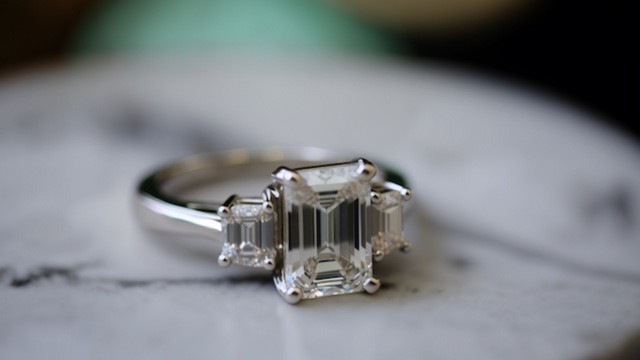12 Most Popular Diamond Cuts For Engagement Rings
Proposing is an extraordinary experience.
When choosing a diamond for your engagement ring, the cut is one of the most important factors to consider. A diamond’s cut determines its overall beauty and sparkle and can also affect its value.
From brilliant round diamonds to mesmerizing emerald cuts, here are 12 of the most popular diamond cuts for engagement rings that will surely bring out the sparkle in your special someone’s eyes.
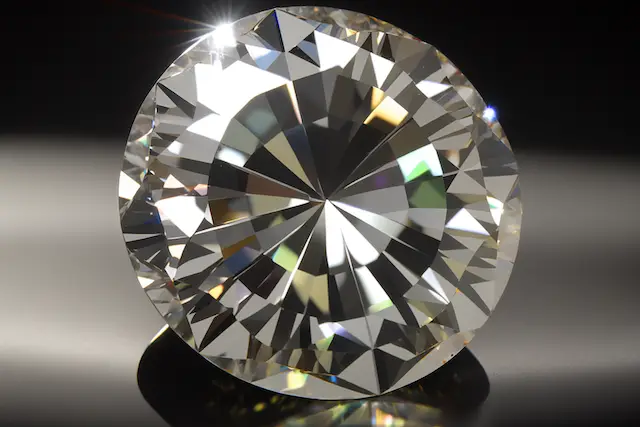
1. Round Brilliant Cut Diamond
The timeless Round Brilliant Cut is a gorgeous choice for an engagement ring, and its scintillating sparkle leaves no one in doubt as to why. Its symmetrical facets on the crown and pavilion reflect light in a brilliant display, captivating onlookers.
This round cut offers endless possibilities for customization, making it highly versatile – suitable no matter what the style of setting or metal type. With 58 facets housing 33 on the crown and 25 on the pavilion, this diamond truly steals the show – providing radiant shimmer and shine!
Characteristics
- Circular shape with 57 or 58 facets.
- Reflects maximum light for maximum sparkle.
- Ideal for those who want a traditional, classic look.
- It can be used with any type of ring setting.
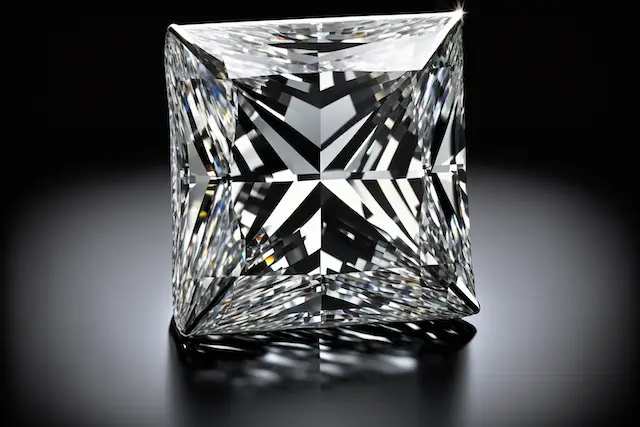
2. Princess Cut Diamond
The Princess Cut diamond is second only to the round brilliant cut in popularity.
This square-cut gem radiates with a modern edge, featuring 56 and 76 facets that amplify the sparkle and magnificence.
Its sharp lines create a captivating brilliance making it a great option if you want something that looks different from a classic round shape but still provides plenty of sparkle.
Princess-cut diamonds have many benefits that make them ideal for engagement rings. First, their symmetrical shape makes them perfect for setting into solitaire rings or halo settings, which allow their sparkle to be fully showcased.
Plus, because princess cuts have less surface area than round brilliant diamonds of the same Carat weight, they usually cost slightly less per carat – making them an excellent option for those who want to save money on their ring without sacrificing quality or beauty.
Finally, because they have sharp edges, princess-cut diamonds tend to look bigger than round diamonds of the same carat weight – the corner-to-corner length of princess diamonds is longer.
Characteristics
- Square shape with pointed corners.
- Known for its sharp, clean lines.
- Ideal for those who want a contemporary look.
- They are often used in solitaire or three-stone ring settings.
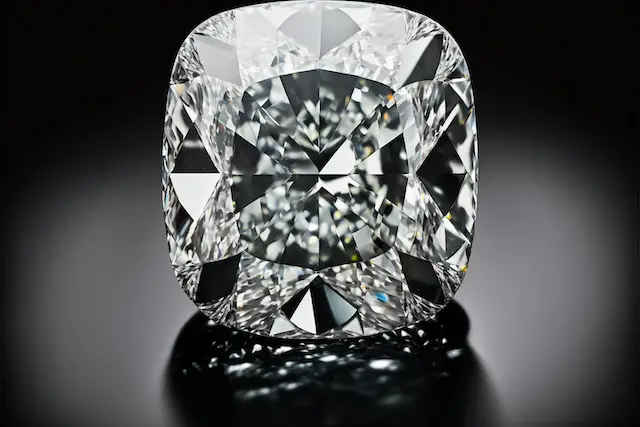
3. Cushion Cut Diamond
Featuring perceptible round corners and 58 alluring, brilliant-style facets that evoke a luxurious pillow shape, this square or squarish-rectangular cut is nothing short of dazzling, giving it an art deco look that is both timeless and contemporary at once.
It has more in common with the Old Mine-cut diamonds of the 1700s than any other modern diamond shape. The softness of the rounded corners gives an antique feel that makes them popular among brides who want something timeless and classic.
The brilliance of your diamond is determined by how well it reflects light back to the viewer’s eye. Cushion-cut diamonds have a larger table than other cuts, so they tend to be less brilliant than round or princess cuts. However, if you choose a high-quality stone with good clarity and symmetry, your diamond will still reflect plenty of light and sparkle.
Characteristics
- Rounded square or rectangular shape with rounded corners.
- Softer, romantic glow compared to other cuts.
- Ideal for those who want a vintage-inspired look.
- It can be used in any type of ring setting but is often paired with halo or vintage-style settings.
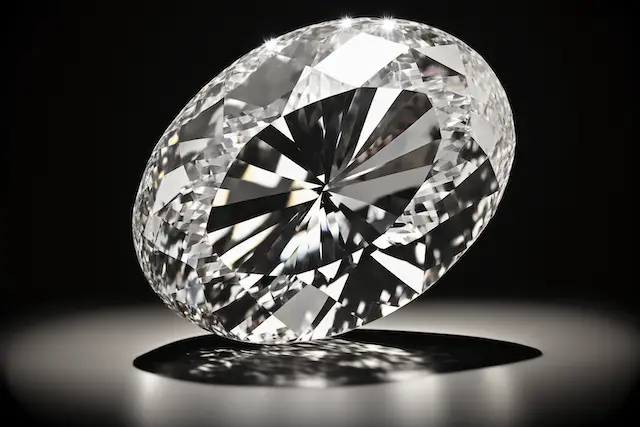
4. Oval Cut Diamond
An Oval-Cut diamond is one of many stunning options when selecting a center stone for your engagement ring or wedding band due to its distinctive silhouette and brilliant sparkle. Its elongated shape has 58 facets and makes it appear larger than other diamonds with similar carat weights—plus, its brilliant sparkle makes it stand out even more!
Oval-cut diamonds were first created in the 1960s by Russian diamond cutter Lazare Kaplan. The idea behind this new cut was to maximize a diamond’s brilliance by combining facets from several traditional cuts.
This allowed more light to reflect off the stone, creating a stunning sparkle that could not be achieved with other cuts. While oval-cut diamonds are modern inventions, their unique shape has made them timeless classics in the world of jewelry and fashion.
Characteristics
- Symmetry: Oval-cut diamonds are known for their even, balanced symmetry and are often used to elongate the finger.
- Brilliance: The elongated shape of an oval-cut diamond allows for a good return of light, giving the diamond a high brilliance.
- Versatility: The oval-cut diamond can complement a wide range of engagement ring styles, from vintage-inspired to modern designs.
- Length-to-width ratio: The length-to-width ratio of an oval-cut diamond is a crucial factor in determining the diamond’s appearance, with ratios between 1.3 and 1.6 considered ideal.
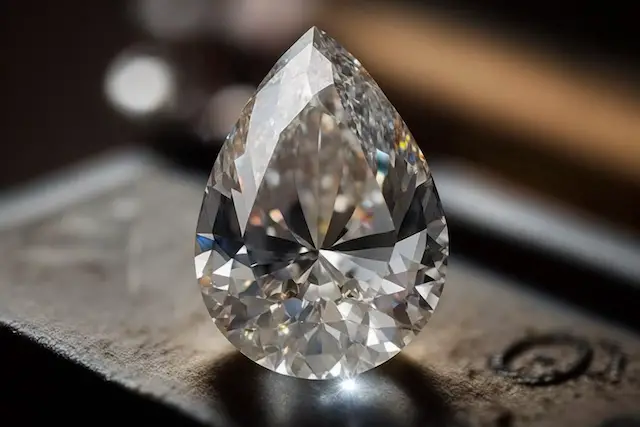
5. Pear Cut Diamond
An illustrious Pear-Cut diamond is a spectacular way to show your everlasting love! This gorgeous stone, crafted by a Flemish polisher Lodewyk van Berquem in the 1400s and known as the “teardrop of the gods,” has captivated admirers for centuries. Its iconic shape inspired radiant variations like marquise and oval cuts, making it truly unique.
A pear-cut diamond offers an exquisite choice for those seeking an engagement ring that will dazzle all others. It emanates breathtaking beauty when set in any metal or band style – single or with other stones – creating a timeless design that will leave your beloved speechless!
Characteristics
- Unique shape: A pear-cut diamond features a rounded end and a tapered point, giving it a distinct and elegant look that sets it apart from other diamond shapes.
- Versatility: The pear cut can be set in a variety of engagement ring styles, making it a versatile option for many couples.
- Increased surface area: Due to its shape, a pear-cut diamond has an increased surface area, which can enhance its brightness and overall sparkle.
- Flattering fit: The shape of a pear-cut diamond can flatter the finger and enhance the wearer’s hand, making it a popular choice for engagement rings.
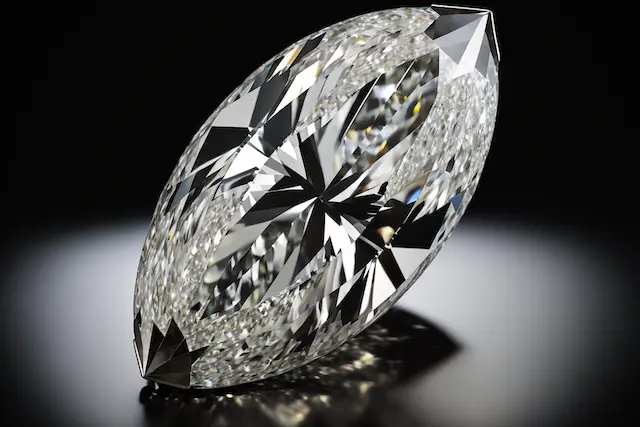
6. Marquise Cut Diamond
This spectacularly designed, elliptical-shaped cut diamond with pointed ends showcases an incredible 56 or 58 gorgeous and dazzling facets with great brilliance and fire.
The Marquise-Cut diamond was first developed in France in the late 18th century when King Louis XV commissioned it from his court jeweler. According to legend, King Louis wanted something that resembled the shape of his mistress’ mouth and asked his jeweler to create it.
Its unique shape will ensure that your ring stands out amongst all the rest. Plus, its elongated design creates an optical illusion of size—so you can get a larger stone without breaking the bank!
Characteristics
- Elliptical shape with pointed ends.
- It creates a slimming effect on the finger.
- Provides a larger surface area than other shapes of similar carat weight.
- Unique and eye-catching design.
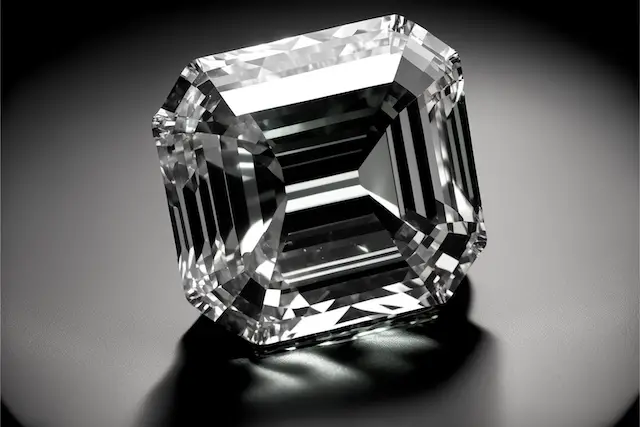
7. Emerald Cut Diamond
Adorned with timeless elegance, Emerald Cut diamonds boast an iconic rectangular shape with step-cut facets for extraordinary brilliance.
This remarkable gem holds 57 facets to create dazzling fire and sparkle that will leave its admirers in awe.
The facets of this precious stone are arranged in three rows along the top of the stone (the table), complemented by two long sides (the pavilion) and two shorter ones (the girdle).
Emerald cuts often appear larger than their carat weight would suggest – so if you’d like to make her ring even more spectacular without breaking the bank, consider investing in an emerald-cut diamond!
Emerald cuts often appear larger than their carat weight would suggest – so if you’d like to make her ring even more spectacular without breaking the bank, consider investing in an emerald-cut diamond!
Emerald cuts often appear larger than their carat weight would suggest – so if you’d like to make her ring even more spectacular without breaking the bank, consider investing in an emerald-cut diamond!
Characteristics
- Rectangular shape with cut corners and step cuts.
- Unique, radiant glow.
- Ideal for those who want a sophisticated, classic look.
- They are often used in vintage-inspired or solitaire ring settings.
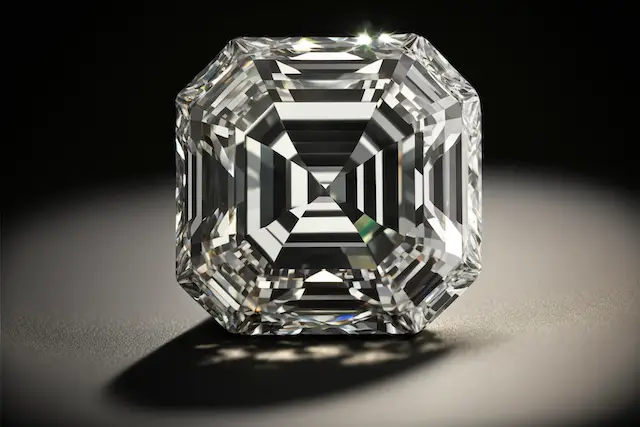
8. Asscher Cut Diamond
Exuding elegance, the Asscher Cut is a mesmerizing square-shaped diamond with 58 luminescent facets that sparkle like no other and make it an exceptional alternative to its emerald-cut sibling. It radiates fire and brilliance – sure to captivate any onlooker’s attention!
The Asscher cut is also known for its high clarity rating. When properly cut, an Asscher diamond will reflect more light than other types of diamonds with similar carat weights. This makes it ideal for those who want to show off their diamond’s brilliance without purchasing a larger stone.
It’s worth noting that since this type of diamond reflects more light than others with similar carat weights, an Asscher cut engagement ring could be more cost-effective than traditional round or princess cuts—so you’ll get maximum sparkle without breaking the bank!
Characteristics
- Square shape with cut corners.
- The step-cut faceting pattern creates a “hall of mirrors” effect.
- The high crown and deep pavilion create a high level of brilliance and fire.
- Uniquely vintage appearance with art deco influences.
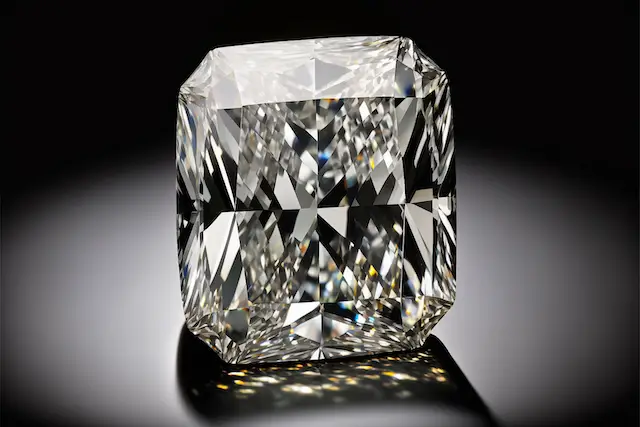
9. Radiant Cut Diamond
With a rectangular-shape silhouette resembling that of an emerald-cut diamond, radiant diamonds are crafted with facets comparable to those of round diamonds instead of the step-cut of an emerald.
Radiating with 70 facets, the radiant cut is an exceptionally luminous diamond option for those seeking a genuinely brilliant sparkle.
Featuring trimmed corners that resemble an octagon, their unique shape helps accentuate the stone’s brilliance and creates a stunning sparkle when it catches the light.
The shape also gives off an unmistakable vintage feel, making it perfect for those who appreciate classic style with a modern twist.
Characteristics
- Square or rectangular shape with cut corners and brilliant-style cuts.
- Combines brilliance and fire of Round Brilliant Cut with clean lines of Emerald Cut.
- Ideal for those who want a modern-vintage, stylish look.
- It can be used in any type of ring setting but is often paired with halo or three-stone ring settings.
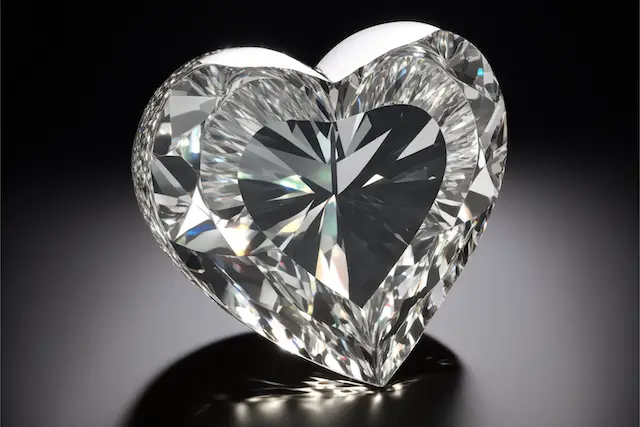
10. Heart Cut Diamond
If you aim to express affection and love, the Heart Cut diamond shape has precisely what you need. Boasting 56 or 58 facets for added brilliance and a fiery radiance, this particular cut of diamonds is perfect for those seeking to symbolize their deepest emotions.
A Heart-cut diamond is exactly what it sounds like—a diamond that has been cut into the shape of a heart!
This cut is achieved by taking the stone and cutting its top face into two symmetrical halves. It requires precision and skill to get it right, which is why it’s often considered one of the most challenging cuts to master.
Heart-cut diamonds are truly timeless symbols of love and devotion. Plus, since they require such skillful craftsmanship to be created properly, you can be sure that your piece will be truly unique in every way!
Characteristics
- Unique and romantic shape.
- Symmetry is crucial for optimal appearance.
- The pointed tip and rounded curves create a distinctive look.
- It can appear larger or smaller than its actual carat weight.
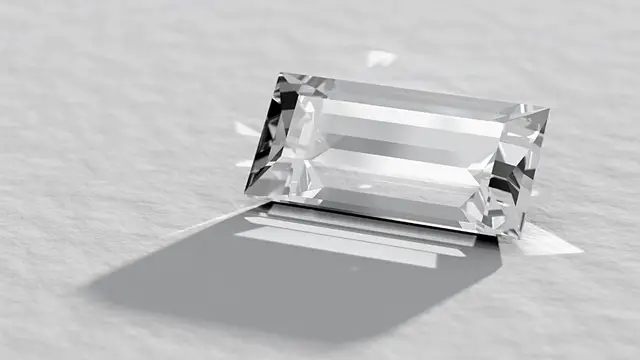
11. Baguette Cut Diamond
The Baguette-Cut diamond is perfect for those who desire a unique and understated style. Its thin, rectangular shape features 14 facets compared to the traditional round-cut diamond’s 58, creating a subtle yet timeless look.
This elongated silhouette adds elegance to designs featuring multiple stones, never detracting from the surrounding pieces. Baguette diamonds are excellent as standalone pieces in engagement rings and earrings. Add sophistication to any piece with this classic cut.
Characteristics
- Rectangular shape with straight sides and cut corners.
- Usually small in size, used as accent stones or in channel settings.
- Step cut style with parallel lines extending from top to bottom.
- High clarity is preferred due to the step-cut style that reveals inclusions easily.
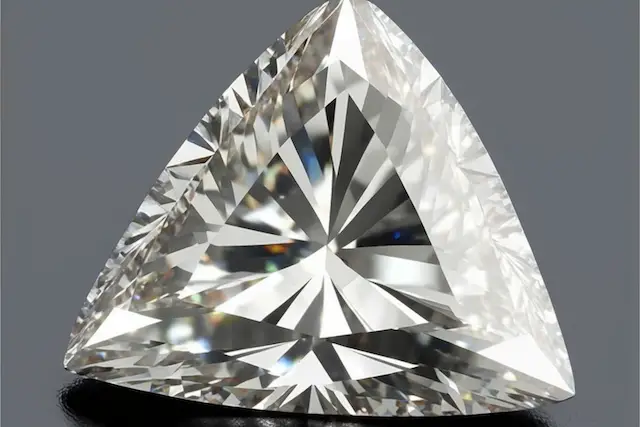
12. Trillion Cut Diamond
The Trillion Cut diamond is perfect if you’re looking for something extraordinary! This innovative cut provides an exciting alternative to traditional round and princess cuts.
A Trillion-cut diamond is just that—a triangular-shaped diamond with three equal sides, each measuring 60 degrees in angle.
Featuring three equal sides and sharp points, an exquisite Trillion cut diamond sparkles with 31 to 50 facets and is ideal for trendy brides.
Trillion-cut diamonds can be featured as either statement pieces or subtle accent stones, depending on your style and look.
Characteristics
- Trillion Cut Diamonds have a triangular shape with pointed corners.
- This cut has 31 or 50 facets, providing a high level of brilliance and sparkle.
- Trillion Cut Diamonds have a unique and modern appearance.
- This cut is often used as an accent stone in engagement rings to complement a center diamond.
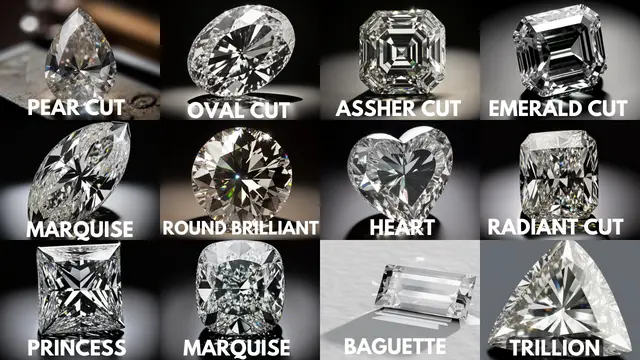
Frequently Asked Questions
Which Diamond Cut Sparkles The Most?
Diamond experts consider the Round Brilliant Cut as the cut that sparkles the most. This is due to its 57 or 58 facets which allow the maximum amount of light to enter the diamond and reflect back, creating a stunning display of sparkle.
The round cut has a classic and timeless look, making it a popular choice for engagement rings. Additionally, the round cut has the most uniform shape, allowing for the most balanced and symmetrical distribution of light and sparkle.
The round brilliant cut was developed in the early 20th century by mathematician and gemstone cutter Marcel Tolkowsky, who studied the principles of light reflection and refraction to create the ideal cut proportions.
He designed a round cut with 57 or 58 facets that maximized the reflection and refraction of light, creating a brilliant and fiery sparkle. The industry quickly adopted the design, and has become the standard for round diamonds ever since.
What Diamond Cut Looks Biggest?
The Marquise-Cut diamond is the best choice if you’re looking for a stone that appears larger than its actual carat weight. This elongated shape is perfect for those who want to add an extra level of glamour and sophistication to their piece. The unique shape also provides more surface area, making it appear larger than other diamond cuts.
Runner up in terms of size appearance is the Oval Cut Diamond. The oval shape also has an elongated structure, giving it a larger surface area and appearing bigger than other diamond cuts. It’s also worth mentioning that both of these cuts are great for those with smaller finger shapes, as they help to make your fingers appear longer.
Which Diamond Cut Holds Its Value?
According to diamond experts, diamond cuts that retain their value well are Round Brilliant, Princess, and Cushion Cuts.
These cuts are classic and timeless, with high demand in the market, and they maintain their popularity over time.
The round brilliant cut is the most popular cut due to its sparkle and symmetry, making it a safe choice for retaining value.
The princess and cushion cuts are also popular due to their modern look, versatility, and good value retention.
Additionally, the trillion-cut diamond is highly sought-after for its unique shape and sparkle. However, it is essential to note that the value of a diamond depends on various factors such as the 4C’s (carat, cut, color, clarity), certification, and market demand, not just the cut.
Which Diamond Cut Is The Most Expensive?
The most expensive diamond cut is the round brilliant cut due to its popularity and demand and its intricate process of cutting and shaping to maximize its brilliance and fire.
Other cuts, such as the emerald cut or the princess cut, may also be costly, depending on the quality and size of the diamond. Still, the round brilliant is often considered the most expensive overall.
This is because of its popularity, timeless shape, and perfect symmetry, which results in a spectacular sparkle and fire that any other diamond cut can’t match.
The round brilliant also requires significantly more waste of rough diamonds during the cutting process than other cuts, resulting in a higher cost for the same weight of the diamond.
Additionally, the round brilliant cut is considered a classic and timeless shape, contributing to its enduring popularity and higher price. For these reasons, the round brilliant diamond remains the most expensive diamond cut.
Which Diamond Cut Sparkles The Least?
You may think that Baguette cut diamonds are not known to be the least sparkling diamonds, but they are not designed to have a lot of sparkle.
With this said, the lowest sparkle diamond is actually the Asscher cut.
The Asscher cut was originally designed to be a square emerald cut, but its unique shape and large facets give it a very low sparkle level.
The step faceting of the Asscher and its shallow depth and smaller table cut reduces how much light can reflect off its surface, giving it an overall duller appearance compared to other diamond cuts.
Which Diamond Cut Looks The Smallest?
The diamond cut that appears the smallest is generally considered to be the Baguette Cut. This is due to its straight lines and elongated shape, which often make the diamond seem smaller than other cuts with more facets and rounded shapes.
Additionally, baguette-cut diamonds are typically cut with fewer facets than other diamond cuts, which also contributes to their appearance of being smaller.
Which Diamond Cut Looks The Smallest?
The diamond cut that appears the smallest is generally considered to be the Baguette Cut. This is due to its straight lines and elongated shape, which often make the diamond seem smaller than other cuts with more facets and rounded shapes.
Additionally, baguette-cut diamonds are typically cut with fewer facets than other fancier diamond cuts, contributing to their smaller appearance.
When it comes to fancier cuts, it is somewhat debatable. The Asscher-cut diamond appears to be somewhat small due to its unique square shape and lower sparkle level.


